A Solar Startup that Isn’t Afraid of Solyndra’s Ghost

There is no doubt that last year’s bankruptcy of Solyndra, a maker of thin-film solar panels that received a $535 million loan guarantee from the U.S. Department of Energy, is casting a huge shadow over the market for solar power. So it’s no surprise that when SoloPower, another Silicon Valley manufacturer of solar panels, opened the first 100-megawatt production line of its planned 400-megawatt manufacturing facility in Portland, Oregon, this week, it raised eyebrows and howls of protest.
Indeed, the news media and various solar observers were quick to point out the obvious. SoloPower makes CIGS-based solar panels, the same technology used by Solyndra. And like its failed predecessor, SoloPower has been awarded a federal loan guarantee (its $197 million loan was approved last year during the same month that Solyndra announced bankruptcy, though SoloPower hasn’t begun tapping into the money). What’s more, SoloPower is targeting the same niche market as Solyndra: rooftops of industrial or commercial buildings.
But while the comparison might be obvious, it also might be flawed. Solyndra’s bankruptcy had far more to do with its manufacturing and business failures than with flaws in CIGS-based solar panels. Solyndra spent far too much money, far too fast, and produced far more product than it had customers for.
SoloPower, of course, hopes to avoid similar mistakes. The seven-year-old company is targeting the half of all commercial and industrial building owners who can’t use more conventional solar power because their rooftops can’t support the weight of today’s modules, says CEO Tim Harris. As such, the company is betting its lightweight product will command higher prices than those sold as commodities. It will begin by selling in countries such as Japan and Italy that have strong demand for rooftop solar, relatively high peak electricity prices, and some government incentives, Harris says.
As production ramps up, SoloPower, which has been backed by $200 million in private investment since it was founded in 2005, is aiming to improve its modules’ efficiencies to 13 percent by the end of next year, all while proving it can keep costs in check as it scales up manufacturing.
Alain Harrus, a partner at Crosslink Capital, which invested in several financing rounds for the company, calls the market more than sizeable enough if SoloPower succeeds in its goal to own it. He estimates that market at one gigawatt per year installed around the world, and about 3.5 gigawatts in Japan alone over the next eight years as that country aims to reduce nuclear power usage. These are not massive numbers, but SoloPower’s initial production goals are only a small slice of that figure, Harrus says.
And SoloPower is confident it can be a force for expanding the overall base of rooftop solar power applications. “We have more demand than we have capacity for the next couple of quarters,” says Harris, who says SoloPower has customers lined up that are waiting for production in the new facility, which is expected to ultimately create 450 jobs, to ramp up.
Still, SoloPower is entering production during a horrible time for solar panel manufacturers, especially for producers of thin-film technology. While the technology is meant to be cheaper than conventional silicon-based solar cells, the drop in price of silicon technology has largely negated thin-film’s advantage.
Earlier this year, Abound Solar, a Colorado maker of another type of thin-film technology, based on cadmium telluride, announced it would file for bankruptcy. Around the same time, GE announced that it would suspend construction of its proposed plant to make thin-film solar panels. Meanwhile, this August MiaSole, another Silicon Valley maker of CIGS thin-film solar panels, said it was “reorganizing” its manufacturing and operations and looking for a potential partner.
GTM Research senior analyst Shyam Mehta, for one, is skeptical of SoloPower’s prospects. He calls the untapped commercial rooftop that SoloPower is pursuing extremely niche, and even then, he says, project developers will be reluctant to rely on an untested startup that may not be around in 10 years. Unisolar, a subsidiary of Energy Conversion Devices, recently failed in its bid to sell to a similar set of customers.
The DOE is watching. SoloPower will have to meet several performance milestones in the next few months before it can tap the approved $197 million loan guarantee backed by taxpayer dollars. Harris says the due diligence process involved in its application was rigorous, involving 14,000 pages of initial documents and countless follow-up meetings.
He says he feels no added pressure. Just last week, he was walking rooftops in Seoul, Korea, where, he says, his company’s technology would be economical under current power prices.
Keep Reading
Most Popular
Large language models can do jaw-dropping things. But nobody knows exactly why.
And that's a problem. Figuring it out is one of the biggest scientific puzzles of our time and a crucial step towards controlling more powerful future models.
How scientists traced a mysterious covid case back to six toilets
When wastewater surveillance turns into a hunt for a single infected individual, the ethics get tricky.
The problem with plug-in hybrids? Their drivers.
Plug-in hybrids are often sold as a transition to EVs, but new data from Europe shows we’re still underestimating the emissions they produce.
Stay connected
Get the latest updates from
MIT Technology Review
Discover special offers, top stories, upcoming events, and more.